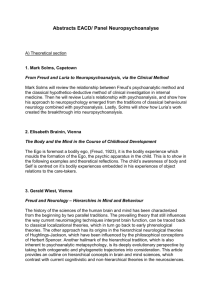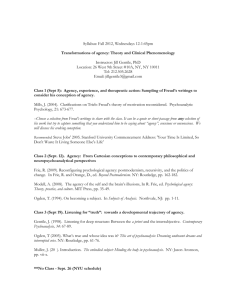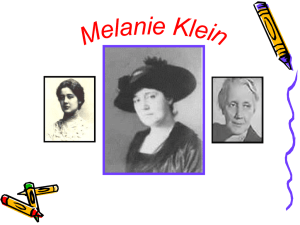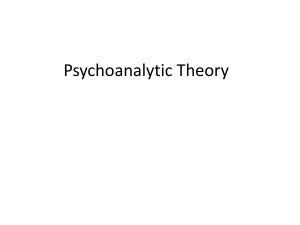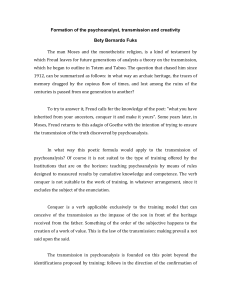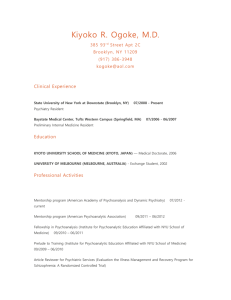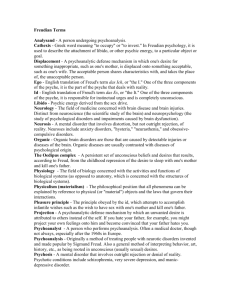PSYCHOANALYSIS AND SCIENTIFIC PSYCHOLOGY
advertisement
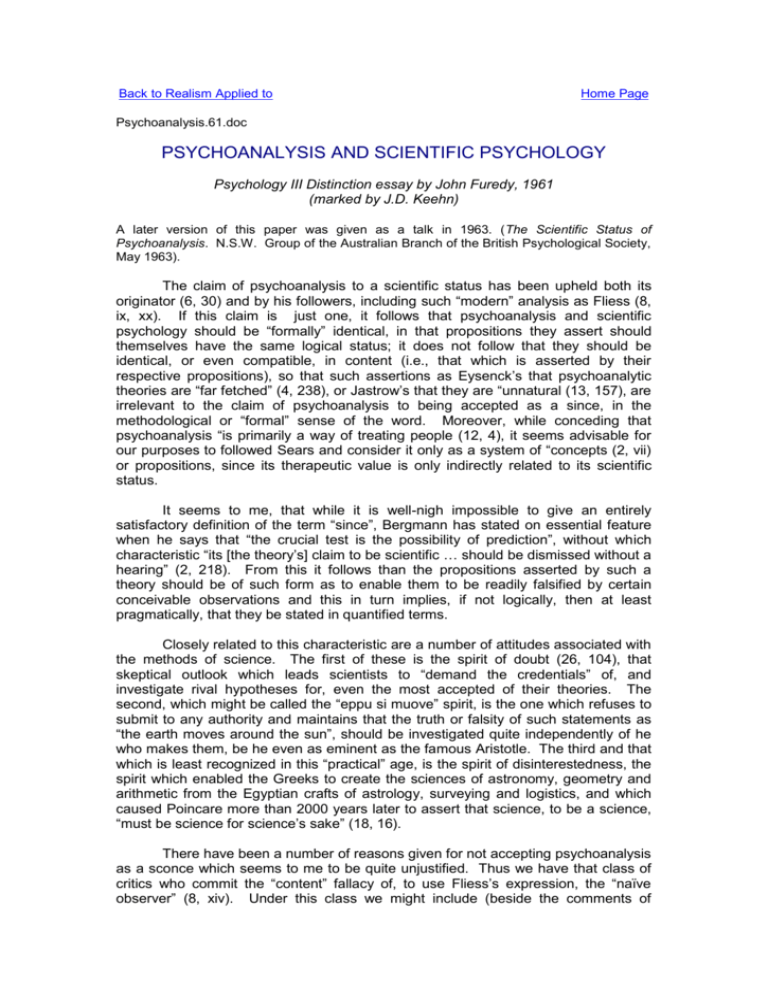
Back to Realism Applied to Home Page Psychoanalysis.61.doc PSYCHOANALYSIS AND SCIENTIFIC PSYCHOLOGY Psychology III Distinction essay by John Furedy, 1961 (marked by J.D. Keehn) A later version of this paper was given as a talk in 1963. (The Scientific Status of Psychoanalysis. N.S.W. Group of the Australian Branch of the British Psychological Society, May 1963). The claim of psychoanalysis to a scientific status has been upheld both its originator (6, 30) and by his followers, including such “modern” analysis as Fliess (8, ix, xx). If this claim is just one, it follows that psychoanalysis and scientific psychology should be “formally” identical, in that propositions they assert should themselves have the same logical status; it does not follow that they should be identical, or even compatible, in content (i.e., that which is asserted by their respective propositions), so that such assertions as Eysenck’s that psychoanalytic theories are “far fetched” (4, 238), or Jastrow’s that they are “unnatural (13, 157), are irrelevant to the claim of psychoanalysis to being accepted as a since, in the methodological or “formal” sense of the word. Moreover, while conceding that psychoanalysis “is primarily a way of treating people (12, 4), it seems advisable for our purposes to followed Sears and consider it only as a system of “concepts (2, vii) or propositions, since its therapeutic value is only indirectly related to its scientific status. It seems to me, that while it is well-nigh impossible to give an entirely satisfactory definition of the term “since”, Bergmann has stated on essential feature when he says that “the crucial test is the possibility of prediction”, without which characteristic “its [the theory’s] claim to be scientific … should be dismissed without a hearing” (2, 218). From this it follows than the propositions asserted by such a theory should be of such form as to enable them to be readily falsified by certain conceivable observations and this in turn implies, if not logically, then at least pragmatically, that they be stated in quantified terms. Closely related to this characteristic are a number of attitudes associated with the methods of science. The first of these is the spirit of doubt (26, 104), that skeptical outlook which leads scientists to “demand the credentials” of, and investigate rival hypotheses for, even the most accepted of their theories. The second, which might be called the “eppu si muove” spirit, is the one which refuses to submit to any authority and maintains that the truth or falsity of such statements as “the earth moves around the sun”, should be investigated quite independently of he who makes them, be he even as eminent as the famous Aristotle. The third and that which is least recognized in this “practical” age, is the spirit of disinterestedness, the spirit which enabled the Greeks to create the sciences of astronomy, geometry and arithmetic from the Egyptian crafts of astrology, surveying and logistics, and which caused Poincare more than 2000 years later to assert that science, to be a science, “must be science for science’s sake” (18, 16). There have been a number of reasons given for not accepting psychoanalysis as a sconce which seems to me to be quite unjustified. Thus we have that class of critics who commit the “content” fallacy of, to use Fliess’s expression, the “naïve observer” (8, xiv). Under this class we might include (beside the comments of Eysenck and Jastrow’s given above) such examples as the ethical (naivety” of Lynch, when he abuses Freud for his “prurient imagination” (15, 256) and the methodological “naivety” of Feiblemnan, when he dismisses the concept of the basis importance of early sexual development by the facile verdict that “the absurdity of such a theory does not require dwelling upon” (6, 314). Again, there are others who would dismiss psychoanalysis on metaphysical grounds, forgetting the science is metaphysically neutral. Examples of this are Feiblmenan's “realist” assertion that “the fact that realism is a valid metaphysical position and nominalism an invalid one would seem … to disprove the scientific claims of psychoanalysis” (6, 308), and Flew’s “materialist” preconceptions in dismissing the Freudian unconscious processes as psychological explanations, on the grounds that they are “not sufficiently substantial” (7, 143). Finally there are the bombastic exaggerators such as Eysenck, who, saying that its assertion are too vague to be tested, compares psychoanalysis to “biblical prophecy” (4, 233), blatantly ignoring the fact that Freud himself tested and found wanting his earlier hypothesis that hysteria was invariably caused by an earlier actually physical seduction (16, 340). However Eysenck’s comment, like most gross exaggerations, is only partly unjustified. For it is undeniable that such concepts as “inhibited aggress” (6, 311) and reaction formation make the predictive power (and consequently the possibility of being falsified) of most psychoanalytic propositions very week indeed. And when, added to this, we consider how completely unquantifiable are such aeteological factors as Oedipus complex, anal fixation, etc., Freud’s own admission that, while “it is always possible by analysis (i.e., post diction) to recognize the causation with certainly”, a “predication of it (the causation) by synthesis is impossible (10, 227), cannot be lightly dismissed as a momentary aberration form scientific principles, but must be considered as indicative of the anti-predictive nature of far too many propositions of psychoanalysis. In any case, while it is true that Freud, after a number of observations, rejected the physical seduction hypothesis for the symbolic and/or physical one, this sort of “self-contained” (4, 232) hypothesis testing, which refuses to consider any asexual explanations 9these being outside the Feudian system) of hysteria, such as 9for example) Eysenck’s inhibition concept, cannot be said to be in accord with the skeptical spirit of science which was mentioned above. This is why Sears, in concluding his empirical study of “the scientific status of the Freudian concepts (22, vii), says that “further analysis of psychoanalytic concepts … may be relatively fruitless as long as these concepts rest in the theoretical framework of psychoanalysis (22, 147). Again, when Freud says, in effect, that no proposition made by an unanalyzed person about psychoanalysis should be considered seriously 9(9, 9304), we can hardly maintain that this sort of appeal to the qualifications of the proposition-maker is compatible with the “eppru si muove” spirit of science. As to the strength of the spirit of disinterestedness in psychoanalysis, it is not surprising that it is so feeble, when we remember that psychoanalysis if primarily a therapeutic tool. Indeed Toulmin is not far wrong when he says that “therapeutic failure is as fatal to an explanation in psychoanalysis as predictive failure is to an explanation ins physics (25, 138). This “practical” element is one of the most important factors in making he term “scientific psychoanalysis” seem at times to be almost sefl0contradictory. Another important factor is the enormous personal influence of Freud himself, if we accept Boring’s description of the early psychoanalytic movements as “a personal school centered on Freud and a group of loyal disciples (3, 707). as essentially correct. And indeed, when finds an “authorized (sic) translation” of the “New Introductory Lectures”, it would seem that Boring’s term “disciples” is a well chosen one and that Landis’s assertion, the trainee analyst “must believe or else” (1, 27), is not such a great exaggeration after all. Thus, while it would be too much to say that all psychoanalytic concepts are unscientific, it must be admitted, that at present there are too many anti-scientific elements in psychoanalysis for it to deserve a fully scientific status. This conclusion however, in no way implies that these elements can never be eliminated and even if this is the case, it does not therefore follow that psychoanalysis is “no good”. The label “scientific”, despite our twentieth century prejudices, has no ethical or pragmatic connotations in the strict sense of the word. Psychoanalysis, even it if is completely unscientific, may still be the best way of curing neurotics. QUESTIONS FOR DISCCUSSION 1. Is there a “science” (i.e., a constant methodology) of a science (16, 27) as S.S. Stevens holds, or is Ruth Munroe more correct when she says that “we cannot blueprint the needs of science in logical terms” (17, 23) and that psychology, being a “lower system” (17, 25) should stop aping physics “beyond what is quite appropriate to its (i.e., psychology) own needs” (17, 23)? 2. Is Feiblau justified in his assertion that “the ahistorical character of science is one of the most notable things about it” (6, 312)? Keehn’s comments (for this teacher who was at Sydney only during the year of 1961, see http://www.psych.utoronto.ca/users/furedy/Papers/ob/keehn4.doc ) on the essay: Mr. Furedy, In this connection it is not really enough to talk about the form of the propositions used in the theory –=more important to examine the terms of the positions. Are they the names of things or processes which could occur, or whose occurrence could be observed, or are they “magical powers”? Really you only approach this question on p. 3 middle para. This consideration really shows that science is not “metaphysically neutral”—it is anti-metaphysical. The other main issue about scientific status is whether the methods of investigation conform to orthodox canons of empirical research (repeatable, etc.), and you make relevant points here. Is “anal fixation” any more unquantifiable than any other psychological concept? Fixation is clearly a quantitative concept in Freud’s view—technique of quantification (scales etc) are completely lacking, but I should think some reasonable attempt at constructing them could be made (has in fact). Grade: AREFERENCES 1. Alexander, F., Boring, E., Sachs, H., Landis, G., Brown, J., Willoughby, R., Symonds, P, Murray, H., Frenkel-Brunsiwick, E, shanow, D. Symposium:Pyschoanalysis as seen by analysed psychologists. J. Abn Psychol, 1940, 35, 3-55, 139-211, 305-325. 2. Bergman, G. On some methodological problems of psychology. Philos of Science, 1940, 7, 205-19. 3. Boring, E. A history of experimental psychology, NY, 1950. 4. Eysenck, H. Sense and nonsense in psychology, 1957 5. _______ What is the truth about psychoanalysis? 1960, 52-57. Reader’s Digest, Feb, 6. Feiblemann, J. Revival of realism. Univ. of North Carolina, 1946. 7. Felw, A. psychoanalytic explanation. Macdonald, Oxford, 1954. Philosophy and Analysis, ed. M. 8. Flies, R., ed. The psychoanalytic reader. London, 1958. 9. Fredu, S. New introductory lectures on psychoanalysis. NY, 1933 10. ---------- Collected papers, vol 11, London, 1933 11. Hilgard Theories of Learning. NY, 1948 12. ---------- Psychoanalysis as a science in Kubie & Windin, eds 13. Jastrow, J. The house that Freud built. London, 1933 14. Karpman, B. Objective psychotherapy. J. Clin Psych, 1949, 193-336. 15. Luynch, A. Science: leading and misleading. London, 1927. 16. March, M. (ed) Psychological Theory: contemporary Readings, NY, 1951. 17. Munroe, R. Schools of psychoanalytic thought. NY, 1959 18. Poincare, H. Science and method. London, 1914. 19. Radcliffe-Brown, A. A natural science of society. Illinois, 1957. 20. Russel, B. The scientific outlook. London, 1934. 21. Saltey, A The case against psychoanalysis. NY 1952 22. Sears, R. Survey of objective studies of psychoanalytic concepts. Social Science Research Council Bulletin No. 51 23. Spence, K. Behavior theory and conditioning. New Haven, 1956 24. Standon, A. Science is a sacred cow. NY, 1952 25. Tolmin, S. The logical status of psychoanalysis. Philosophy and Analysis, ed. W. Macdonald, Oxford, 1953. 26. Wootton, B. Testament for a social science. London, 1950.
